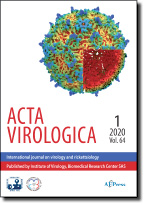Journal info
|
||
Select Journal
Journals
Bratislava Medical Journal Endocrine Regulations General Physiology and Biophysics Neoplasma Acta Virologica Current articles 2023 2022 2021 2020 2019 2018 2017 2016 2015 2014 2013 2012 2011 2010 2009 2008 2007 2006 2005 2004 2003 Studia Psychologica Cardiology Letters Psychológia a patopsych. dieťaťa Kovove Materialy-Metallic Materials Slovenská hudbaWebshop Cart
Your Cart is currently empty.
Info: Your browser does not accept cookies. To put products into your cart and purchase them you need to enable cookies.
Acta Virologica Vol.50, p.75-85, 2006 |
||
| Title: THE ROLE OF VIRAL AND CELLULAR PROTEINS IN THE OF HUMAN IMMUNODEFICIENCY VIRUS | ||
| Author: F.M. MAZZÉ, L. DEGREVE | ||
| Abstract: For over two decades, research on Human immunodeficiency virus (HIV), which is responsible for AIDS, has aimed at understanding of the molecular mechanisms used by this virus during its life cycle. An essential step in the HIV life cycle is the budding, which promotes the release of viral particles from the host cell. It has recently been revealed that HIV in the process of budding uses besides one viral protein also the machinery of the infected cell, in particular the proteins Tsg101 and ubiquitin. The viral protein is the p6 domain of the Gag precursor polyprotein. In normal cells, Tsg101 functions as a regulator of endocytic trafficking that recognizes ubiquitinated cargo and directs its delivery to degradative compartments. In HIV-infected cells, Tsg101 and ubiquitin interact with Gag p6 to promote the release of new viral particles from the host cell. Molecular mechanisms underlying the process of HIV budding from infected cells suggests a whole new range of drug targets that could prove useful in AIDS suppression in HIV-positive patients. |
||
| Keywords: Gag p6 protein; human immunodeficiency virus; budding, multivesicular bodies; Tsg101; ubiquitin | ||
| Year: 2006, Volume: 50, Issue: | Page From: 75, Page To: 85 | |
|
Price:
26.40 €
|
||
|
|
||

